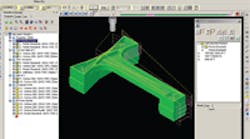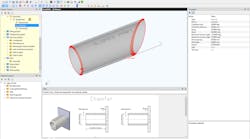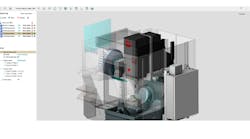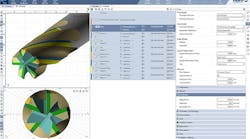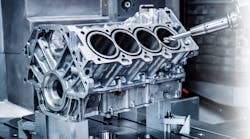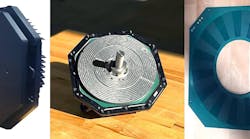Joe Mattes, an injection-molding toolmaker, and Matt Mason, a businessman, launched TR Manufacturing in 2004. They knew they’d have to distinguish their Indiana job shop from others that were failing, so they located manufacturing space and bought a used 3-axis Dah-Lih vertical mill. Then, they spent a considerable amount of time researching every CAD system in the $1,000-$30,000 price range — sensing this would be their most important acquisition and the foundation of their business. Their idea was simple: avoid prints, if at all possible.
Today, Joe Mattes is so firm in opposition to “paper” that he will refer potential customers who want one or two parts manufactured from a print to other shops. TR Manufacturing works almost exclusively with 3D CAD solid or surface models of the parts, and the work comes in over the Internet. The shop immediately imports the model into its CAM system, Mastercam CAD/CAM software from CNC Software Inc.
The shop’s programmer usually generates a CNC manufacturing program in minutes, relying on proprietary libraries of tools, toolpaths, and materials that TR Manufacturing has established for its growing list of machines. The goal is to turn these Internet-sourced projects around in two weeks or less.
So how are they doing? TR Manufacturing now has 100 customers, and few of them are located nearby. Most are concentrated on the East or West Coasts. Since 2004, the partners have added six full-time employees and their equipment list has grown to six CNC mills and three CNC lathes.
DIFFERENT, BUT THE SAME
TR Manufacturing serves customers in various markets, customers that tend to be specialists themselves and who need a fast turnaround on a handful of precision manufactured parts. Some examples are:
• A medical equipment manufacturer that builds a DNA sequencing machine. Each machine costs $3 million, and the company produces just a few units each year.
• A customer that builds a hydraulically driven torque wrench that mounts to the front of a forklift, so the user actually drives up to the bolt. The wrenches are used in hydroelectric dams and shipyards. All the components are similar, but they are customized for different applications and forklift truck models.
• An aerospace manufacturer that has been contracted to design and manufacture seat assemblies for various Boeing passenger jets.
• A manufacturer that converts a number of standard, rear-wheel-drive motocross bikes into two-wheel-drive models.
Recently, Joe Mattes estimated that he was working on about 30 orders from 15 of his customers. The goal, again, in each case is to complete jobs in two weeks or less while getting his customer as close as possible to a finished product. So, TR Manufacturing will add value by doing secondary processes like anodizing or manufacturing complete subassemblies. A lot of the work is in small parts, which the company vacuum-packages in clear plastic so they are well protected and easy to identify.
“We’re in a market where most people would tell you it’s impossible to survive,” Mattes said, “a handful of parts here and there. How can you make money doing that? But that’s all we do.”
GROWING SMARTER
As soon as Mattes downloads a customer’s CAD file, it gets translated into Mastercam. TR Manufacturing has a software maintenance license for Mastercam, so that the company always has the most up-to-date translator for any CAD package a customer might be using.
“One of the big advantages of Mastercam is the ease of dealing with a repeat type of part, not exact but nearly like something you’ve done before,” Mattes explained. “I’ll get a model via email, and it looks like another part we did for the same customer. So I’ll import all the toolpaths and tools I used on that other part and re-select some geometry, and post the program. A lot of times within minutes I have G-code ready to load on the machine and can start making the part.”
Mattes said that Mastercam has a lot of really good default libraries for tools and materials. TR Manufacturing does not use them though. Instead, the company relies on machine-specific libraries that it has developed over many years of using the CAM software. The more it uses the software, the more proprietary knowledge it captures for making subsequent parts better and faster.
He said, “Each machine has its own unique characteristics for roughing, finishing, whatever the case might be. So we have tool and toolpath libraries for each machine. Those are divided further for different materials and such.”
“If we are going to do a 4140 steel job on our Johnford (www.absolutemachine.com) vertical machining center, we have machine-specific toolpath libraries and tools for that. The next job might be aluminum, and there is another set of libraries for that. Every time you click a tool, you don’t have to do any calculations on chip load or surface footage. That work is already figured out. You just click and go.”
Another benefit is that Mattes and his other programmer do not spend a lot of time when using Mastercam to shave 10 seconds here and there off the machine cycle. That would make sense in a production environment, but not in this type of business.
“Our customers don’t pay us for writing G-code,” he said. “They want their parts as fast as they can get them. So the less time we spend programming, the better.”
MORE OF THE SAME
So what’s the next advancement for TR Manufacturing? It depends on what comes in via the Internet from one day to the next. Mattes speculates that the company will become involved in the thriving medical parts manufacturing business, for which Indiana is famous. At the moment, however, the company has stopped actively seeking new customers. Enough work is coming from referrals, so TR Manufacturing’s priority has shifted to searching for a new location because it has outgrown its once nearly empty manufacturing space.
